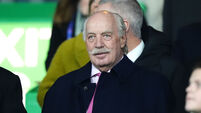Tommy Martin: Do we want our sports books to glorify or tell all?

Ageing baseball pitcher Jim Bouton released Ball Four - a tell-all diary of life inside the dressing room - at the end of the 1969 season. It's time we had a modern version says Tommy Martin.
If you are reading these pages then chances are someone is thinking of buying you a sports book for Christmas.
It might be the autobiography of a celebrated rugby or GAA player, or the authorised account of a title won by your favourite soccer team, in which case they think you are the type who wants to be swept away by heroic tales of sporting glory.
Or they might think you are a cynical sort who prefers to see the gritty reality behind the dream.
Maybe or David Walsh’s , or some other exposé of a grubby sporting scandal.
Fifty Christmases ago American shoppers had the same dilemma: whether to buy their loved one the latest sanitised tome by a sporting legend, or to snap up , the runaway bestseller by an ageing baseball pitcher called Jim Bouton.
Ball Four is Bouton’s diary of the 1969 season with the Seattle Pilots, a club whose playing roster consisted of washed-up has-beens hanging on to the big leagues by their fingertips.
Sounds unpromising? It caused a sensation, sold millions and became a classic. placed it third in their list of greatest sports books of the 20th century.
It wasn’t the first fly-on-the-wall account of life as a professional sportsperson, but it was the first to do it with unsparing honesty. smashed the image of professional baseball as a romantic dream factory. Players were shown to be boozers, womanisers and pill-poppers. As Bouton wrote later, before him sports books were usually “about how important it is to get a good night’s sleep because the team sure needs to win that big game tomorrow.” changed all that.
Its success was also due to timing. struck a chord with the counter-cultural spirit of the late 1960s. Bouton poked fun at authority figures and baseball’s preference for crew-cut conformity.
Coaches were clueless purveyors of useless bunkum. Club owners were greedy, mean and spiteful.
Most shockingly at the time, Bouton revealed revered baseball legends like Mickey Mantle and Whitey Ford, former teammates at the New York Yankees, to be flawed figures. Mantle drank too much and was rude to autograph-hunting kids; Ford tampered with the ball before pitches.
was also riotously funny and, crucially, touchingly vulnerable. The players were insecure, petty and selfish. They were worried about their jobs, their families and their futures. Rather than being untouchable heroes, it turned out they were just like everyone else.
I had occasion to dig out again for an appearance on , the sportswriting podcast from the fine people at The42.ie. I had not been aware that Bouton died last year at the age of 80, a year before his book’s 50th anniversary, facts which only underline its enduring vitality.
Host Gavin Cooney suggested that perhaps we needed another , given the landfill of bland autobiographies that clog up the sports book market today.
The thought put me in mind of something Paul Kimmage wrote in the last month. Headlined ‘350 pages of mind-numbing tedium — recent rugby books are spectacularly ordinary reads,’ Kimmage decried the refusal of Irish rugby stars like Rory Best and Rob Kearney to reveal anything particularly interesting in their autobiographies.
Kimmage writes a similar piece most years. It is a subject which offends the sensibilities of a man whose reputation was built on brutal honesty about the realities of professional sport. His most famous books, and , owe much to Ball Four, whose influence also spawned Eamon Dunphy’s .
When you think of the scandals that have befallen rugby in recent years — the Belfast rape trial, Gerbrant Grobler, painkillers, concussion, various drunken misdemeanours — it would seem to be ripe for a Ball Four.
Still, Kimmage knows well why Ball Fours and Rough Rides are few and far between. Just like Kimmage after the publication of his tell-all memoir about professional cycling, Bouton endured serious personal blowback when his book came out.
While it sold by the bucket-load, baseball essentially blacklisted its author. His career was as good as over just months after publication. Commissioner Howie Kuhn castigated Bouton and tried to get him to sign a statement saying that the book was a work of fiction. Former teammates were outraged at the betrayal of dressing room confidences and the influential sportswriter Dick Young described Bouton as a ‘social leper.’ But the most enduring criticism came from a baseball writer called Roger Kahn, who wrote a scathing review in magazine. Kahn attacked Bouton for breaching the sanctity of the locker room, but was more concerned that he had stripped these heroes of the dignity he felt their feats had earned them.
For Kahn, guys like Mantle and Ford were not just like you and me. They filled the dreams of childhood and lit up the lives of millions. They should be left on their pedestal, not dragged down here with the rest of us.
Two years later Kahn published his response to Ball Four. was an elegiac love letter to the 1950s Brooklyn Dodgers, who Kahn had covered as a beat writer and who he portrayed in romantic terms that evoked the lost age of American innocence and that of its national pastime.
Some critics, Bouton included, said Kahn’s book was too sentimental, as if, according to one reviewer, it had “been removed from the altars of the world’s great cathedrals.” But The Boys of Summer also sold millions and when Sports Illustrated came to judge their books of the century, they put it at number two, one ahead of Ball Four.
In essence, the contrast between the views of Kahn and Bouton is played out on the shelves of bookshops to this day, though few titles come close to either man’s masterpiece.
The bestseller lists suggest there are many who wish to see their sporting heroes remain on the walls of the cathedral; Bouton’s legacy is that there are also plenty who prefer to see them up close and personal.








